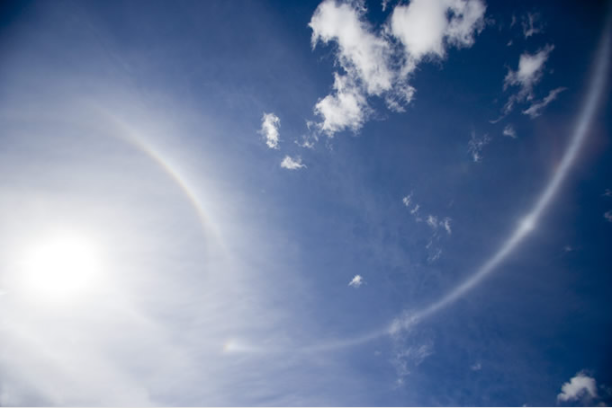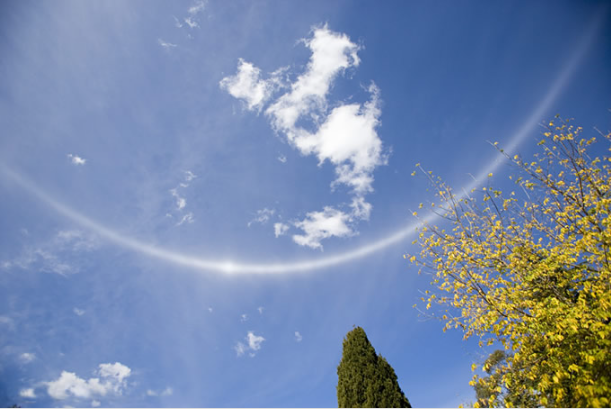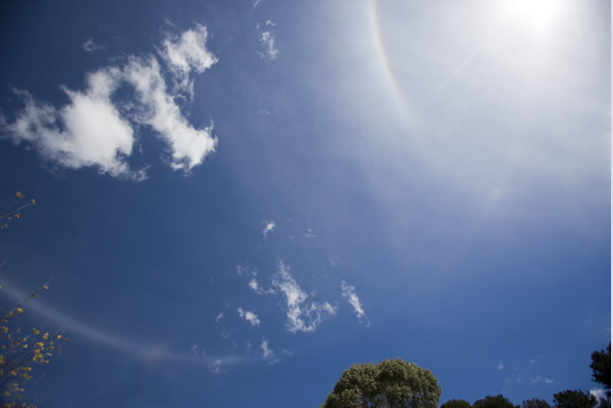Parhelic Circle - Orange NSW Australia
Parhelic Circle: A Phenomenon of Light in Orange, NSW, Australia
In the realm of atmospheric optics, the parhelic circle is a captivating and rare sight. It is a halo-like phenomenon that occurs when sunlight interacts with ice crystals in the atmosphere. On the 14th of April 2006, Noel Dawson captured a remarkable image of the Parhelic Circle over Orange, NSW, Australia. The photograph showcases the extraordinary beauty and complexity of this atmospheric phenomenon.
The Parhelic Circle is formed by sunlight passing through hexagonal ice crystals in the atmosphere. These crystals act as prisms, bending and refracting the light. As a result, the light is split into its constituent colors, creating a circular band of colors around the sun. The circle is typically located at the same elevation as the sun, forming a horizontal ring around it.
One intriguing aspect of the photograph taken by Noel Dawson is the presence of very bright 120° parhelia. These parhelia are highly unusual at such a low solar elevation. They indicate that the plate crystals responsible for their formation were relatively thick. The thickness of these crystals influences the intensity and visibility of the parhelic circle.
The parhelic circle, like many atmospheric halos, is ephemeral in nature. It lasted for a mere 12 minutes in this particular instance. Such brevity adds to the allure and rarity of witnessing this optical phenomenon. The transient nature of the parhelic circle highlights the ever-changing and dynamic nature of our atmosphere.
Capturing an image of the Parhelic Circle requires not only favorable atmospheric conditions but also skill and patience. It is a testament to Noel Dawson's expertise and dedication as an atmospheric optics enthusiast. His photograph serves as a reminder of the intricate beauty that can be found in our natural world.
It is worth noting that the images presented in this article are from the old website and may not appear as intended. However, they still provide a visual representation of the Parhelic Circle phenomenon. For the original article and more detailed information, please refer to the provided link.
In conclusion, the Parhelic Circle over Orange, NSW, Australia is a remarkable display of atmospheric optics. The interplay between sunlight and ice crystals in the atmosphere creates a stunning circular band of colors around the sun. The presence of bright 120° parhelia at a low solar elevation adds an element of rarity to this particular sighting. The ephemeral nature of the parhelic circle further emphasizes its captivating beauty. Noel Dawson's photograph serves as a testament to the intricate wonders that can be found in the skies above us.

Parhelic Circle over Orange, NSW, Australia on 14th April '06.
Imaged by Noel Dawson when the sun was about 43° high. The very bright 120° parhelia are unusual at that solar elevation. They suggest that the plate crystals forming them and contributing to the parhelic circle were quite thick.
The parhelic circle, like many halos, is evanescent. This one lasted all of 12 minutes.
Images ©Noel Dawson, shown with permission.


Note: this article has been automatically converted from the old site and may not appear as intended. You can find the original article here.
Reference Atmospheric Optics
If you use any of the definitions, information, or data presented on Atmospheric Optics, please copy the link or reference below to properly credit us as the reference source. Thank you!
-
<a href="https://atoptics.co.uk/blog/parhelic-circle-orange-nsw-australia/">Parhelic Circle - Orange NSW Australia</a>
-
"Parhelic Circle - Orange NSW Australia". Atmospheric Optics. Accessed on November 26, 2024. https://atoptics.co.uk/blog/parhelic-circle-orange-nsw-australia/.
-
"Parhelic Circle - Orange NSW Australia". Atmospheric Optics, https://atoptics.co.uk/blog/parhelic-circle-orange-nsw-australia/. Accessed 26 November, 2024
-
Parhelic Circle - Orange NSW Australia. Atmospheric Optics. Retrieved from https://atoptics.co.uk/blog/parhelic-circle-orange-nsw-australia/.